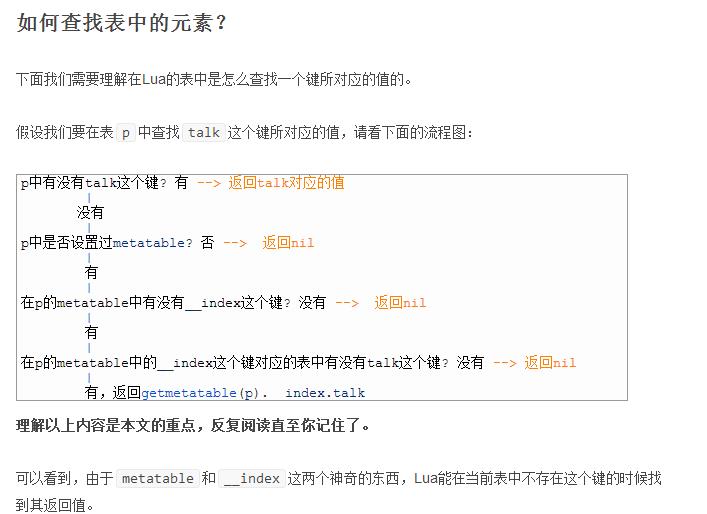Lua
Lua 是一种嵌入式脚本语言,它非常小,速度很快,功能却非常强大。在线的lua解释器
Lua类型
1
2
3
4
5
6
Lua 类型。在 Lua 中,值可以有类型,但是变量的类型都是动态决定的。nil、布尔型、数字 和 字符串 类型的工作方式与我们期望的一样。
Nil 是值为 nil 的一种特殊类型,用来表示没有值。
布尔型的值可以是 true 和 false 常量。(Nil 也可以表示 false,任何非 nil 的值都表示 true。)
Lua 中所有的数字都是双精度的(不过我们可以非常简便地编写一些代码来实现其他数字类型)。
字符串是定长字符数组。(因此,要在一个字符串后面附加上字符,必须对其进行拷贝。)
表、函数 和线程 类型都是引用。每个都可以赋值给一个变量,作为参数传递,或作为返回值从函数中返回。例如,下面是一个存储函数的例子
这里需要注意的是,任何非nil的值都表示true。
函数和循环
lua和python不一样,没有严格的缩进规则。--是lua中的单行注释。
--循环
while condition do
--statements
end
repeat
--statements
until condition
for i = first,last,delta do
--statements
end
--函数
function f(n)
local x = 1
for i = 2, n, 1 do
x = x * i
end
return x
end注释
--单行注释
--[[多
行
注
释]]闭包函数
function add(x)
return function(y)
return x+y
end
end
f = add(2)
--function(y) return 2+y
f(3)
--5lua中的数据结构
Table
tables是lua内置的唯一的复合数据结构,和python的字典是一样的
a_table = {} -- Creates a new, empty table
a_table = {x = 10} -- Creates a new table, with one entry mapping "x" to the number 10.
print(a_table["x"]) -- Prints the value associated with the string key, in this case 10.
b_table = a_table
b_table["x"] = 20 -- The value in the table has been changed to 20.
print(b_table["x"]) -- Prints 20.
print(a_table["x"]) -- Also prints 20, because a_table and b_table both refer to the same table.
print(b_table.x) --Also prints 20,syntactic sugarArray
一维数组,lua中的数组下标是从1开始的。
array = {0,1,2,3}
print(array[2]) -- print 1
print(#array) --# is the length operator for tables and strings.
array[0] = 1 --下标0也是合法的,但是计算数组的长度是从下标1开始计算的
print(#array)//表容器的循环
for key, value in pairs(_G) do
print(key, value)
end二维数组
ExampleTable =
{
{1,2,3,4},
{5,6,7,8}
}
print(ExampleTable[1][3]) -- Prints "3"
print(ExampleTable[2][4]) -- Prints "8"1
Using a hash map to emulate an array normally is slower than using an actual array; however, Lua tables are optimized for use as arrays[9] to help avoid this issue.
metaTables
metaTable非常厉害,它可以让我们定制自己的表,在键不存在的时候,我们会查看元表中的__index对应的表。
--斐波那契数组
fibs = { 1,1 }
count = 0
setmetatable(fibs,{
__index = function(values,n)
values[n] = values[n-1]+values[n-2]
count = count + 1
return values[n]
end
})
a1 = fibs[10]
print(count) --print 8
a2 = fibs[9]
print(count) --print 8__index是一个lua预定义的一个函数,它会在n不存在的时候调用。
lua的面向对象编程
类是成员变量和成员方法封装在一起的一个抽象,用类作为模板实例化的就是对象。
类中的成员变量和成员方法都可以用键值对表示,键是变量名或者函数名,值就是对应的数值或者方法。
metatable是我们用lua编写类的核心。metatable(元表)的作用就是帮我们的表扩展既定的操作。本质上,元表也是一个表。
全局方法setmetatable(table,m_table)可以将表table的元表设置为m_table,getmetatable(table)可以获取table的元表。
元表中有lua预定义的方法,这些方法都是以__开头的,这些元方法定义了我们想对表的自定义的操作。
构建类最核心的就是lua的表是怎么查找一个键对应的值的流程。如图:

代码:
local Vector = {}
Vector.__index = Vector
function Vector:new(x, y, z) -- The constructor
return setmetatable({x = x, y = y, z = z}, Vector)
end
function Vector:magnitude() -- Another method
-- Reference the implicit object using self
return math.sqrt(self.x^2 + self.y^2 + self.z^2)
end
local vec = Vector:new(0, 1, 0) -- Create a vector
print(vec:magnitude()) -- Call a method (output: 1)
print(vec.x) -- Access a member variable (output: 0)这里面最核心的一步是将我们的类的__index键设为自身。在构造函数中,我们把类模板作为我们实例对象(表)的元表。这样做的结果我们调用类中的成员方法实际上是使用getmetatable(object).__index.method。
class.method = function(arg)
--dosomething
end
function class.method(arg)
--dosomething
end
function class:method(arg)
--dosomething
end上面的代码中的写法是完全等价的,这是lua中的syntactic sugar。
参考资料:
1.使用 Lua 编写可嵌入式脚本
2.wiki
3.Lua中实现类的原理
1
FIN 5.30/21.07